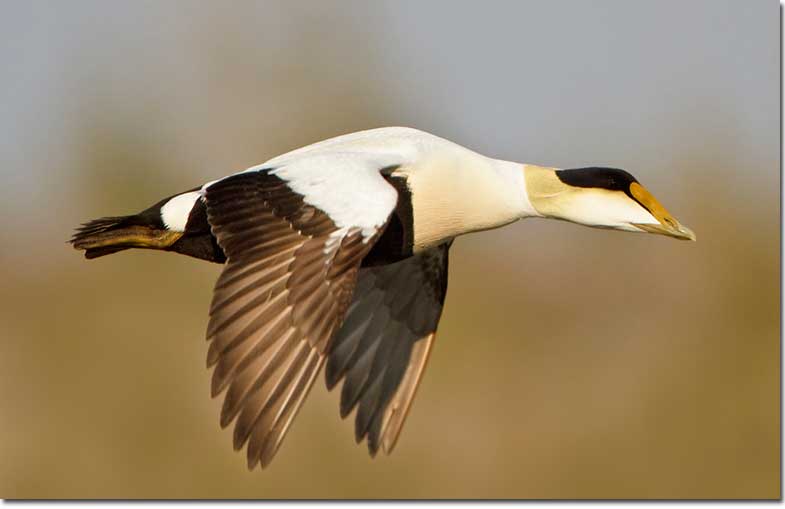The Common Eider (Somateria mollissima) is a robust sea duck, known for its dense and insulating plumage, mostly thriving in arctic and subarctic coastal habitats of North America.
Males in their breeding plumage are a stunning combination of black and white with a green patch on their face whereas females are mottled brown. Let’s take a closer look at one of the largest ducks in North America!
On this page
Identification
Common Eiders are robust and bulky ducks with a rounded shape, especially noticeable in their bodies and heads. Their bills are long and wedge-shaped, extending almost as high as their crown, and their tails are short and wedge-shaped. They are among the largest ducks in North America, measuring 19.5-28 inches long with a wingspan of 31-43 inches. Their bill colors vary from olive-gray to orange.
Male
Male Common Eiders are bigger than females and have bold and contrasting plumage. They have a white back, forewings, chest, neck, and head. Their sides, underside, and rump are black, and they also have a black cap. This is coupled with a pale green patch on their cheeks and the side of their neck, making the male easily recognizable in their breeding plumage.
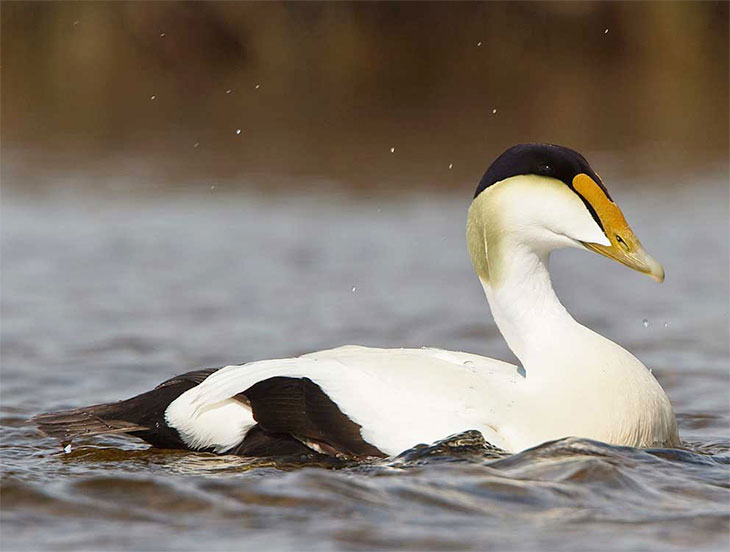
Photograph © Glenn Bartley
In their eclipse plumage, they have dark mottling on their breast and back. This diminishes the black-and-white contrast and the overall brownish appearance helps them become more unnoticeable.
Female
Female Common Eiders have a more cryptic and mottled plumage year-round, offering them camouflage. Their plumage is mostly warm cinnamon-brown with dark overall barring. They have pale grayish-brown heads.
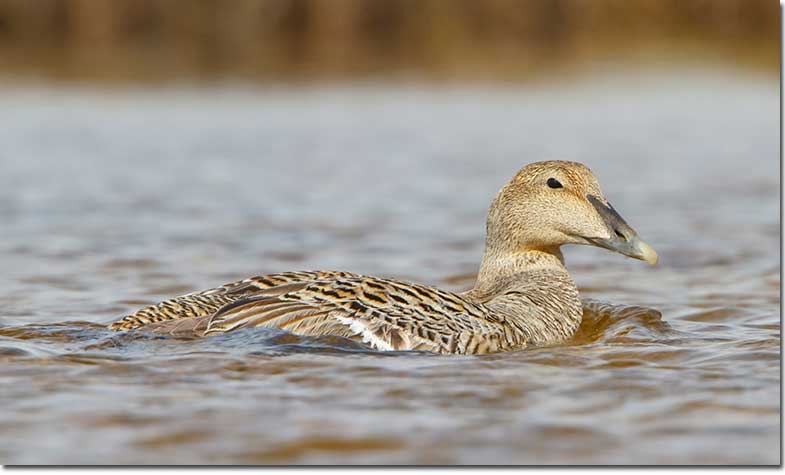
Juvenile Common Eiders resemble adult females in their coloration, with a mottled dark and white plumage. Males go through various molts, including one where they are dark overall with a white breast and some white mottling on the back.
Vocalizations
Common Eiders are vocal, especially during the breeding season. During courtship, males emit various soft cooing and hooting sounds to attract females which may sound like rah-ool. Females respond with rapid quacking calls that sound like gog-gog-gog. If threatened, both sexes can give a harsh kor-korr-korr call.
Food
Common Eiders are carnivores with their diet primarily consisting of marine invertebrates. This includes various species such as mussels, clams, snails, crabs, amphipods, marine worms, fish eggs, sea urchins, aquatic insects, scallops, and small fish. They may forage both during the day or at night but prefer to do so at low tide or on falling tide.
Common Eiders have a fascinating way of catching their meals. When foraging in groups, they dive into the water with a sense of order, resembling a synchronized swimming routine.
The leaders take the plunge first, and the rest follow suit. The feeding sessions are quite short, lasting around 15-30 minutes, after which they head for the shore to rest and digest. This is repeated several times a day.
Most of their foraging is done underwater. However, if they happen to forage in shallow water, they may just opt for up-ending or swimming with their head submerged to reach their food. Ducklings also eat some marine algae instead of being on a purely carnivorous diet.
Nesting and Eggs
Common Eiders do not mate for life but they remain monogamous for the breeding season and sometimes reunite in the following breeding seasons. In courtship, males give their soft hooting or cooing calls to attract females. They then toss their heads, flap their wings, and stretch their necks to impress the female.

Eiders often nest in colonies. Females choose the nesting site, which is on the ground and near the water, generally slightly sheltered by vegetation or rocks. The nest itself is a shallow depression in the ground, measuring around 8.5 inches across and 2.7 inches deep. Females line it with their own down feathers and it looks like a bowl of fluff!
They have only one brood in a year with 1-8, generally 3-5 eggs in a clutch. Common Eider eggs are unmarked olive-gray and measure around three inches long and two inches wide.
The female incubates the eggs alone for 24-26 days while the male may keep watch. Shortly after hatching, the offspring follow their mother to the water. They are responsible for feeding themselves, but the female will guard and care for them. The young fledge at 30-50 days of age.
Current Situation
Common Eiders range across the northern coasts of North America, eastern Siberia, and Europe. In North America, they breed as far south as Maine along the east coast and as far south as the Alaskan Peninsula on the west coast. They migrate a bit further south and outward toward the sea for the winter, although southernmost breeders are more or less resident.
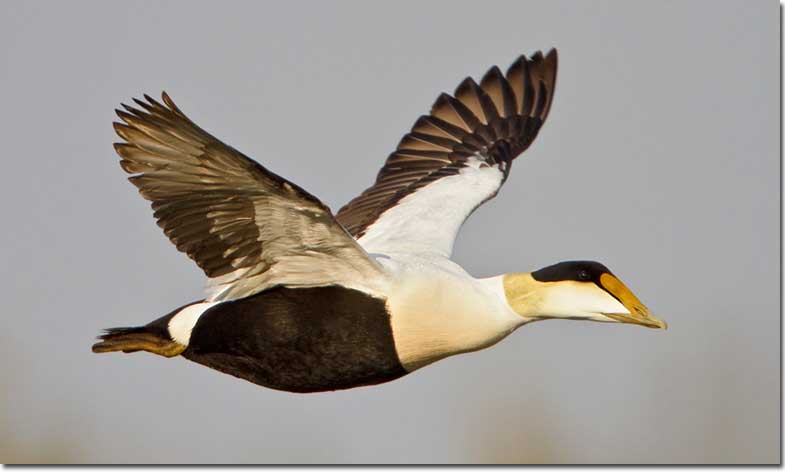
Common Eiders prefer to stay very close to the coast at all times. They favor rocky coasts and islands and also tundra for nesting. On migration, you may see them on fresh water as well.
During the winter, they are typically found in places that have a lot of mollusks, strong tides, and rocky seafloors. They are often found in shallow ocean waters.
Common Eiders are listed as a near threatened species on the IUCN Red List. They are rather numerous with 750,000 breeding pairs in North America, but are facing several threats, including oil spills, overharvesting of their main food source, and low survival rate of the ducklings.
Facts
- Common Eiders are fairly powerful birds. They can fly at speeds of up to 70mph and dive up to 65 feet deep!
- Female Eiders often return to the same place where they hatched to reproduce, which leads to their high degree of relatedness in any given location. This is also believed to be the reason why eiders breed cooperatively, including laying eggs in other nests and females teaming up to care for their ducklings.
- Common Eiders have a disgusting but effective way of defending their eggs. If they’re spooked, they poo on their eggs before running off.
- Common Eiders can live up to 20 years in the wild with the oldest individual on record making it to 22 years and 7 months. The survival rate of adults is very high, ranging from 80-95%! However, on the other hand, the survival rate of ducklings is very low. They get killed by starvation, exposure, and predators and it is considered lucky if one duckling out of the clutch makes it.
Similar Species
Common Eiders do not have many similar species and the two that they have are also eiders! Here they are and how to tell them apart.
King Eider
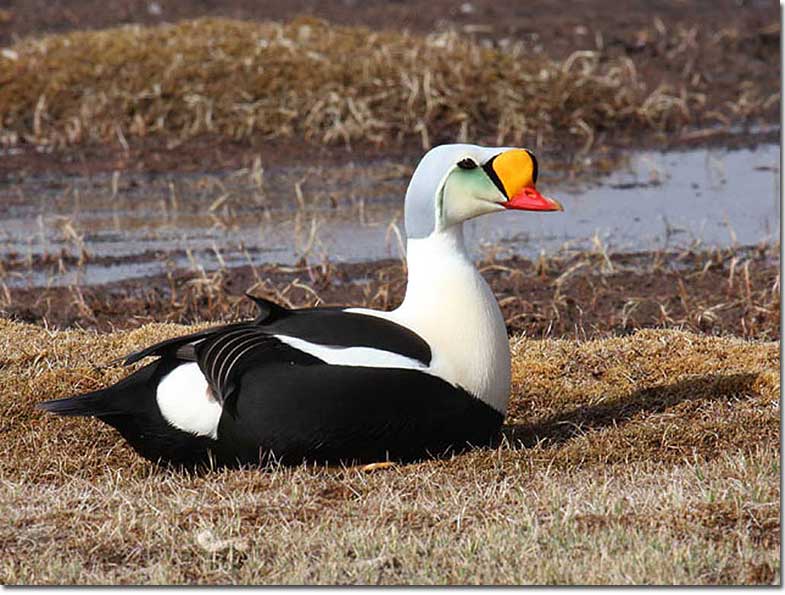
King Eiders more or less share the same range as Common Eiders in North America. It is a large sea duck, although not as large as the Common Eider. Males are white on the flanks, back, chest, neck, and face and black on the lower part of the body, rump, and parts of the wing. They have grayish caps, a pale green wash to their face, and a large orange plate above their red bills. Females are mottled in brown and black and have a black bill.
King Eiders are smaller than Common Eiders. When it comes to males, then King Eiders have black backs and a visibly blocky head with bright orange bills whereas male Common Eiders have a white back and a wedge-shaped head with a dark cap. Females are more similar, but King Eiders have a rounder head.
Spectacled Eider
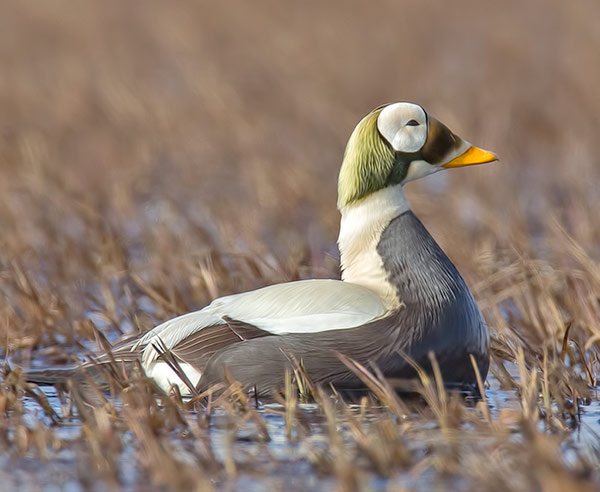
In North America, Spectacled Eiders can only be found around Alaska. Males have mostly white upperparts and black underparts. They have wedge-shaped heads, orange bills, and a distinctive face pattern that makes it look like they’re wearing spectacles. Females are tan with darker brown barring and dark bills.
Male Common Eiders lack the spectacled look the Spectacled Eiders have and they also have a white instead of a black breast. Females are a bit more difficult to tell apart, but pay attention to their faces. Female Spectacled Eiders have a pale eye patch mirroring the spectacled look of the male, whereas the female Common Eider does not have it.
Frequently Asked Questions
Where do Common Eiders live?
Common Eiders live in subarctic and arctic coastal areas of North America.
What are the predators of Common Eiders?
Predators, such as gulls and foxes, pose a threat mostly to the eggs and ducklings of Common Eiders.
Do Common Eiders quack?
Female Common Eiders give hoarse quacks.

